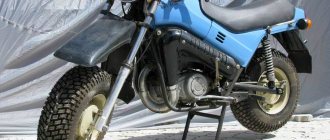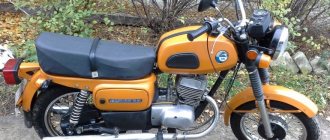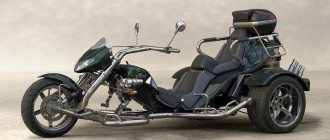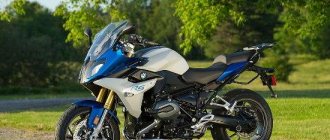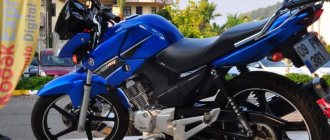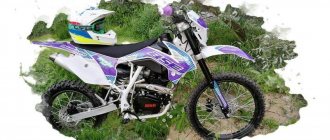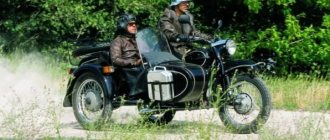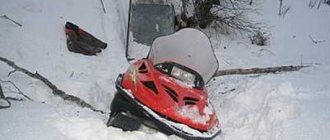Despite quite active attempts by a number of companies to establish the production and sale of scooters in the USSR, this type of equipment has practically not taken root in our country. One of the reasons for the cold attitude of residents towards mopeds was the poor quality of roads, which did not allow all the advantages of the concept to be realized. This is how a new Tula motorcycle appeared.
Specialists at the Ryabikov Machine-Building Plant in Tula knew about this problem. In 1984, a new design was implemented and an all-terrain motorcycle was put into production, and where an electric starter was installed. Contrary to popular belief, this model was never called Tula 200.
An average of 11,000 motorcycles were produced per year for 12 years . They appealed to different categories of motorcyclists, but they were especially popular among villagers who went out to hunt and fish with them.
Detailed approach
“Tula” is an interesting motorcycle in its design and unusual in design. The concept of the car was quite interesting. Durable duplex frame, long-travel shock absorbers, air-cooled engine, off-road tires...
All this made the Tula motorcycle very promising. Nevertheless, the fate of this technology cannot be called successful. Why? Let's try to understand the reasons for this state of affairs. To understand them better, let's start with the basic parameters.
Notes
- [retrocar.by/opyt-ekspluatatsii-vsedorozhnogo-mototsikla-tmz-5951-tula Experience in operating an off-road motorcycle]
- [www.motodrive.com.ua/content/history-9/TMZ-5951_Tula-358.html ]
- ↑ 12
[roker.kiev.ua/techinfo/mototsikl/tula-tmz-5-952/motocikl-tula-menyaetsya-k-luchshemu.html Tula is changing for the better. Motorcycle Tula TMZ-5.952] - [roker.kiev.ua/techinfo/mototsikl/dalnobojj-na-motocile-tula/na-tule-iz-leningrada-v-tulu.html On the “Tula” from Leningrad to Tula]
- O. Kurikhin
Passions for the Tula motorcycle (Russian) // Youth technology: magazine. - 2001. - May. — P. 26. - [retrocar.by/cheburashka-suzuki-rm-mototsikl-tula Cheburashka + Suzuki RM = motorcycle “Tula”]
Main characteristics
Let's be honest, the characteristics of the Tula are not decisive when evaluating a motorcycle. But since many people pay attention to them first, we will not break tradition. A brief technical description is as follows:
- Engine: Gasoline, two-stroke, single-cylinder, equipped with a forced cooling system. 200cc engine See Develops 12.5 horsepower in the TMZ-5.951 and 13 hp. in later version TMZ-5.952. At speeds of 4900-5500, the maximum torque is reached, which is 1.8 kgf m. The oil had to be poured directly into the fuel (oil mixture in a ratio of 1:33).
- Starting system: from starter-generator.
- Main fuel: A-76 gasoline.
- MS-20 oil was added at the rate of 25 grams per liter of fuel.
- Gearbox: pedal, 4 gears.
- The maximum speed is 85-90 kilometers per hour, depending on the modification.
- Fuel consumption (combined): 3.6 liters per 100 km.
- Fuel reserve/reserve: 11/0.5.
- Weight (dry): 129 kg for early modifications and 126 kg for later ones.
- Wheelbase - 1330 millimeters.
The trucks had a chain drive on the rear wheel, front telescopic forks and rear suspension with wishbones. And then... Then there were problems that could not be solved.
Disadvantages of the model
Nowadays you rarely see this model of bike on the roads. But he did not completely disappear from our roads. You can also find and buy a “Tula” motorcycle if you wish. His photo, however, will not always fully correspond to the original design. Over the years, most models have undergone a number of changes.
The decrease in demand is based on a number of shortcomings that are characteristic of this type of vehicle. Among them are the following:
- Low maximum speed.
- Heavy weight, which affects off-road driving.
- Due to the large width of the wheels, the motorcycle tends to “bump” when cornering. On wet road surfaces, the wheels lose stability.
- The installed starter required a higher starting power from the battery. Therefore, two of them were installed on the first models. In the USSR at that time there simply were no batteries with a small size and high current. For the later version, only one battery was left.
Despite its shortcomings, the Tula motorcycle takes its place in the history of technology development in Soviet times.
Many problems
Yes, the Tula motorcycle is really good off-road. With the right skill, the driver could even move across a plowed field. However, on roads with smooth asphalt, the motorcycle did not feel comfortable. This was influenced by both the relatively low speed and the peculiarity of the engine, the main parts of which were borrowed from the unit used on the Tula 200 scooter.
Special tires with tread have sizes 6,7 and 10, they provide good grip on the road surface while maintaining minimal ground pressure. The asymmetrical design of the engine shifted its center of gravity to the side. It also didn't improve cornering handling.
He lacked speed. On the track, the Tula motorcycle could overtake a moped, but was seriously outperformed by traditional road motorcycles. I'm not happy with it and the fuel consumption is high for a car of this class. Motorcycles of the first series had a fuel tank consisting of two halves that were not connected to each other. This was very inconvenient, and then the problem was solved by installing one tank.
Of particular concern to those who drove the Tula motorcycle was the starter-generator (dinosaur). Reliable starting or battery charge levels are often not possible. Moreover, the domestic industry at that time did not produce compact twelve-volt batteries capable of delivering high starting current.
Initially, the truck had to be equipped with two batteries, which significantly increased its weight. One battery format for the Tula motorcycle appeared only on a later version, so for those who bought the Tula motorcycle, the technical characteristics were secondary.
Frame and wheels
The Tula motorcycle (photo can be seen in this article) is built on a duplex frame, the quality of which is quite acceptable. It has a high torsional rigidity. Thanks to this, the developers were able to achieve improved handling.
As mentioned above, the motorcycle is equipped with small wheels with wide profile tires, more suitable for scooters. Due to the small diameter, the center of mass has decreased and road grip has improved. This has led to improved sustainability. The increased width of the wheels made it possible to reduce pressure on the ground and thereby increase cross-country ability.
Unknown story
Despite the above-mentioned disadvantages, people from the outback have shown interest in this particular technique. Due to the specific design of the equipment, tuning has become a favorite pastime of many owners.
Most often they did:
- Replace the brakes (drum on the front wheels, disc on the rear wheels).
- Many people want to install a five-speed gearbox.
- Change the battery (12 volts, capacity 7 Ah).
This gave TMZ specialists the opportunity to develop several additional options, among which there was even a three-wheeled base for motor vehicles produced in the small Tula series TMZ-5.971.
The three-wheeled model (tricycle) was supposed to be an alternative to the popular TGA 200 Muravy scooter. It is unknown exactly how many of these trucks were built. The collapse of the USSR and associated economic problems affected the work of TMZ.
To survive, defense industry enterprises, including Zakłady Budowy Maszyn in Tula, sometimes even took risky actions. Another attempt was made to improve the Tula motorcycle and promote the model to the European market.
However, it soon became clear that according to EEC standards, a motorcycle with such a strongly displaced center of gravity could not be accepted for use. In the early 90s, the quality of products began to suffer, and after 1993, the production of motorcycles sharply decreased. In 1996, their production was curtailed.
Motorcycle tuning Tula
If you managed to find a Soviet Tula motorcycle in the modern world, then it will probably require minor repairs, maintenance or tuning. What can be done?
- Install the Racer engine, which has a power of 14.3 hp. and a working volume of 200 cubic meters, air cooling. After this, the speed of the bike will increase to 100 km/h.
- Install a five-speed gearbox.
- Replace the 12 Volt battery with a capacity of 7 Ah.
- Change the brakes: drums at the front and discs at the rear.
- Paint it.
- It is advisable to change the wiring.
Confused names
As for the confusion with the name Tula 200, that’s a different story. This was the name of the scooter, the production of which was organized at TMZ in 1956. This model almost completely copied the German Glas Goggo TA55 scooter. The machine turned out to be quite successful. It’s just that the Tula 200 served as the basis for subsequent modifications, such as the Tourist and Tulika.
The TGA 200, created on the basis of the same units, appeared almost simultaneously with the Turist scooter. The basis for the design of the power units of all these options was the T-200 engine, which appeared in 1956. Supplemented with an air-cooling system and a modified engine, it was also used on the Tula motorcycle. Apparently, it was for this reason that some, out of habit, began to call the bike Tula 200.
In 1994-1995, the plant also launched the production of Vepr motorcycles, which differed from previous models by stamped collapsible 16-inch wheels and a more powerful generator (160 W). The generator itself (and dyno starter) were a new design, which required minor modifications to the engine crankcase and crankshaft. In addition, contactless electronic ignition (BESZ) began to be installed on these models, and later on “Ant” scooters. However, as operating experience has shown, the BESZ and the dynostarter itself often failed. In total, about 100 Vepr motorcycles were produced.
Three versions
- TMZ-5.951. It was produced for 6 years, starting in 1984. It weighed 129 kilograms. It could reach a speed of no more than 85 kilometers per hour. The engine had a power of 12.5 horsepower.
- TMZ-5.952. It was also developed and produced for 6 years, since 1990. Equipping with a lighter frame made it possible to reduce the total weight by 3 kg. The engine has become more powerful, although only half the horsepower has increased. Speed performance increased - now it was possible to accelerate to 90 kilometers per hour.
- TM3-5.971. It was assembled and produced at the same time as the previous version and was actually its redesigned version with the TMZ-9.906 cargo module. The frame has been strengthened. However, neither the engine nor the steering wheel with the front fork have undergone any changes. The model was a three-wheeled motorcycle with a trunk weighing 129 kg (without a passenger). It was also provided for attaching a trailer for 1 quintal of cargo. The connecting nodes were hidden under a plastic lining.
Links
- [roker.kiev.ua/techinfo/docs/mashina-povyshennoj-proxodimosti/tula-5-951.html Tula 5.951 All-terrain vehicle], magazine “Behind the Wheel” No. 11, 1985
- [roker.kiev.ua/techinfo/mototsikl/tula-v-rukakh-selskogo-zhitelya/tula-tmz-5-951-glazami-selskogo-zhitelya.html “Tula” in the hands of a villager], magazine “Behind the Wheel” No. 9, 1989
- [roker.kiev.ua/techinfo/mototsikl/dalnobojj-na-motocile-tula/na-tule-iz-leningrada-v-tulu.html On “Tula” from Leningrad to Tula], magazine “Behind the Wheel” No. 8, 9, 1990
| : Incorrect or missing image | To improve this article it is desirable:
|
Owner reviews
“Cool motorcycle - Tula!!! My friends and I used this to go fishing after school when we were kids. Excellent for driving on bad roads, even where SUVs cannot always pass.” (Alexey, Novosibirsk)
“For fishermen and motorcycle tourism, where there is heavy loads - just the thing! And it’s an excellent option for rural soil. Of course, it differs in design from other bikes, but I wouldn’t exchange it for modern ones.” (Nikitich, Sharya)
“In the summer it is quite suitable for trips to the river and the forest. In winter it’s better to ride a snowmobile =) Since the designers working at the enterprise developed a power unit based on an engine from Tulitsa, they added a reed valve to it at the inlet, as a result, fuel consumption decreased - this is very important for the village, where gasoline is in short supply. " (Vasya Levy, Krasnoyarsk)
“The disadvantages of Tula are that dirt and water can get into the wiring. Then there are a lot of problems with this. Rights are needed. Pros: simplicity and ease of maintenance.” (Nikolai, Minsk)
“I didn’t like the bike’s poor stability in inclement weather and its tendency to clip when turning, which is due to the wide tires. I installed a foot mechanism on my massive unit in addition to the starter. " (Nikolai, Minsk)
Price
Since the production of Tula motorcycles has been discontinued, it is impossible to purchase a new copy. In the advertisements there are offers of almost new motorcycles with a mileage of 100-150 kilometers, which have simply been sitting in garages for a long time. Prices for motorcycles vary depending on their condition and tuning, but there is a certain range and ranges from 15 to 50 thousand rubles.
Note for connoisseurs
If you liked this story and you are not indifferent to the history of domestic cars, then on our website you will find a lot of useful information. Here you can find out what a good Muravy scooter is and what advantages the Izh Jupiter-5 motorcycle has, and much more. You can also add a comment to this article, or share it on social networks. We will be happy to respond to your feedback.
Test menu:
- Go to Main page
- about the project
- Groups and categories
- Privacy Policy
- Latest posts by the author - links to content
- See car ratings
- Contacts
- Site Map
Specifications
| Maximum engine power: | 12.5 - 13 HP |
| Working volume: | 200 cm3 |
| Motor type (cylinder arrangement, number of strokes): | 1-cylinder, 2-stroke |
| Number of cylinders: | 1 |
| Number of valves: | |
| Intake type (Injector / Carburetor): | |
| Bore and stroke: | |
| Starting system (Electric starter, kick starter): | |
| Maximum speed in km/h: | 85-90 km/h |
| Cooling system: | Air |
| Transmission (gearbox): | Mechanical 4-speed |
| Clutch (Dry / Wet): | |
| Drive unit: | Chain |
| Frame: | Steel |
| Chassis | |
| Suspension (front/rear travel): | |
| Brakes (Front/Rear): | |
| Wheels / Tires / Rubber: | |
| Dimensions and weight | |
| Dimensions (Length / Width): | |
| Seat height: | |
| Ground clearance: | |
| Curb weight: | |
| Weight: | 126 - 129 kg |
| Fuel tank capacity: | 12 l. |
| Battery capacity: | |
| Year of release: | |
| Country of Origin: |
